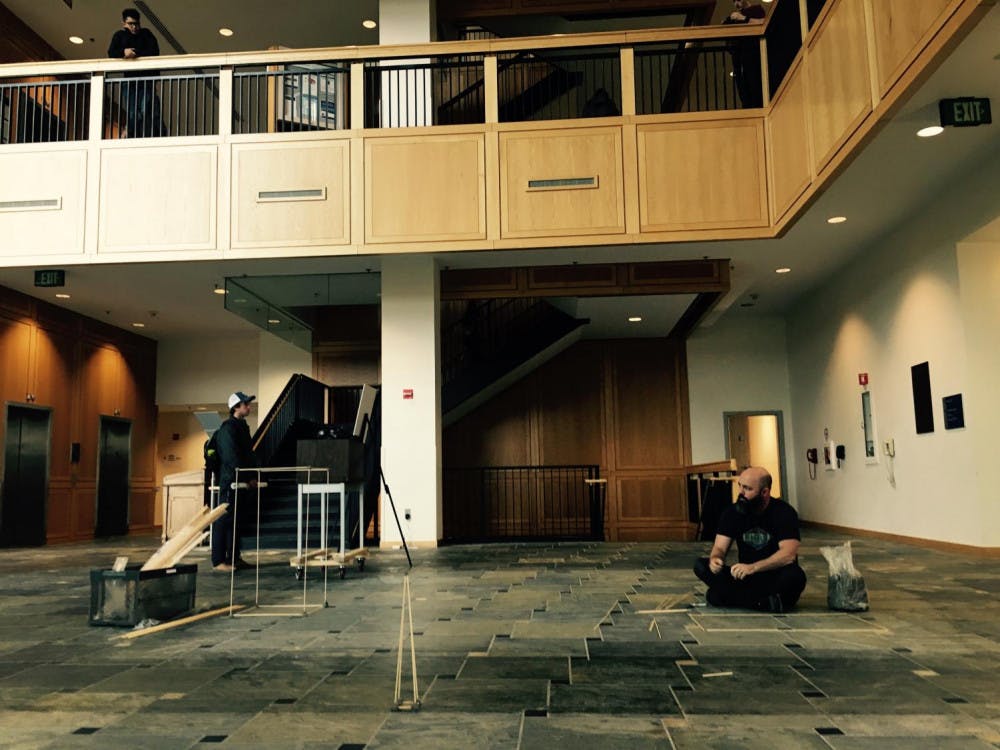During your daily trek to classes, the library, or your favorite dining hall last week, you may have encountered an unusual sight – people making interpretive movements while donning headphones and walking around a public space. If you stayed for long enough, you might have noticed that the ordeal seemed entirely unplanned: over the course of an hour or so, random passersby would occasionally enter the space, receive a pair of wireless headphones and a written prompt, participate in a spontaneous, improvised performance for several minutes and then continue on with their day. Some people simply stood by and watched, while others walked past the scene without a second glance.
Also known as drop-in dance performances, these informal, audience-based productions popped up twice last week, once in the Great Hall of Bicentennial Hall and once on the patio outside Ross Dining Hall during the lunch rush. The heavy foot traffic around these venues allowed for a large number of students to observe and potentially engage with the performance.
A third art installation took place within the Warner Hall Greenhouse on Wednesday evening, April 13, though this one did not involve audience participation. Students and trained performers danced around inside as random passersby observed through the glass.
These improvisational performances came as part of the Movement Matters program, a two-year residency through the Andrew W. Mellon Foundation and Middlebury College Dance Program that uses movement to explore the intersectionality across disciplines. The team consists of choreographer and performer Maree ReMalia; sound designer David Bernabo; choreographer, dancer and educator Jil Stifel; and visual artist Blaine Siegel. Based in Pittsburgh, they are melding their different artistic fields together through participatory events.
“The very nature of these drop-in events is that it’s not necessarily a viewer who is sitting and being danced at,” Stifel said. “It’s something that you happen upon the same way you happen upon a flower. It’s something to be engaged with and interested in before moving on.”
Rod-based installation pieces were prominent in both performance venues. Constructed by Siegel and placed artistically throughout the space, these flexible physical structures were available for participants to interact with, destroy and rebuild.
Each drop-in performance was set against a score that sourced sounds from the organic farm and select locations on campus. Created by Bernabo and audible only to the headphone-wearing participants, the score served as both the ambience and inspiration for physical expression. This phenomenon is commonly referred to as “silent disco” – the experience of dancing to music that only one person can hear.
To initiate the self-improvised performances, each participant was offered a written prompt. These statements ranged from straightforward (“Yell at the space,” “Start a movement and repeat it with growing intensity” or “Swirl”) to silly (“Find a happy dance in your feet and get groovy”) to abstract (“Decorate the air with your movement” or “Respond to the architecture with textured movement”).
The Movement Matters team recognized that the significance of interpretive dance may not be immediately apparent to the viewer – or to the performer, for that matter. However, they expressed hope that participants benefited from the spontaneous, non-verbal expression of the self.
“During our event at BiHall, we were asked by a student why what we are doing is important. It’s a good question – especially in an environment that runs on assignments, discourse and evaluation,” Stifel said. “Through research, we know some of the ways that we can foster resiliency in our brains are through mindfulness, exercise and social connection. By taking time to move our bodies with other people following specific prompts, we are engaging all of those practices at the same time. In this way, the act of dropping into a movement exploration is an artful way of strengthening our powers of resiliency.”
That is not to say that everyone felt quite ready to engage, however. Some people turned around and walked the other way when they saw the installation, as they did not want to cross through the space. Others talked to the facilitators of the event as they walked by, but did not participate. This hesitancy speaks to the perceived inaccessibility of dance – a non-verbal medium of expression that often leaves viewers feeling more confused than enlightened.
As such, ReMalia acknowledged the importance of meeting individuals where they are and not pushing them too far past their comfort zones.
“It’s a process,” she explained. “For someone who doesn’t encounter dance or move in a certain way very often, even coming upon it can be the first step.”
Indeed, the post-performance reflections of some participants expressed appreciation for the spontaneous exercise.
“Freeing and I smiled the whole time. It didn't matter what others were doing, just what I felt moving through,” one person wrote.
“It was interesting seeing all around me and being fully visible yet having physical constraints,” another said.
And finally: “I had a baby 4 months ago and all throughout pregnancy and early infancy, my body was a principle factor in day to day life. Not so much recently. Finding a ‘happy place in my feet and getting groovy’ felt really good. Thank you.”
Drop-In Dance Performances Entice Passersby

Comments



